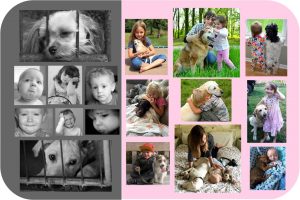Babies, Small Children and Old Dogs
Two songs—“Teach Your Children” and “Respect”—are going through my head right now as I sit here thinking about what I want to say in this blog.
The #2 reason given by people who contact Old Dog Haven asking us to help them re-home their senior dog is that the dog is having problems with small children and/or the baby in the house. We receive these requests multiple times a day—every day.
Senior dogs—like many senior people—often have little tolerance for loud noises, lots of commotion, and change. Also, the reaction time of a dog slows as he ages, and if you add loss of vision, hearing or mobility, a senior dog often becomes a target for small children and many times he will feel vulnerable. Small dogs seem to have a harder time than bigger dogs because it’s easy for small children to pick them up and haul them around, but it’s the bigger dogs that get laid on and pulled on. If a child gets the “wrong” spot when he pulls on a dog because the dog is sore from arthritis or the child startles the dog (deaf dog sleeping), it could be the time the dog reacts and bites. Regardless of the size of the dog, young children need to be taught how to interact with older dogs. You wouldn’t let your young child chase or pull on your grandmother would you? And, using the same comparison, you wouldn’t give your child away if he bit grandpa would you? It’s very important for parents to take the time to teach their children to be kind and respectful to the family dog.
And then there’s the issue of babies and old dogs. Babies can be noisy. If a dog is already nervous or has issues with change, having a baby in the house will probably be hard on him. This is something parents need to think about before deciding to have a baby. Parents need to be honest with themselves about whether they (and the dog) can handle it. It’s far better to find the dog a home before he has a bad experience (and while he’s a little younger.) Once the dog has bitten the baby/toddler he will be extremely hard to rehome and may have to go through a quarantine period. Parents are responsible for making sure both baby and dog are safe at all times. Even if the dog is fine until the baby starts crawling, once that baby is mobile parents need to be sure the baby and the dog interact appropriately. That takes monitoring.
Here are some of the comments we hear all the time from people who contact Old Dog Haven asking us to help them re-home their senior dog:
- “My dog was my first baby but now I have a real baby.”
- “The dog was fine until the baby came home and she started crying.”
- “We’ve moved the dog into the garage because of the baby and now the dog is anxious and barks all the time.”
- “The dog bit the crawling baby twice.”
- “The dog snapped at the kids because they were chasing him and lying all over him.”
- “With the kids and my job, caring for the dog is just too much—I can’t handle it all.”
Senior dogs can live very successfully with babies and/or small children BUT parents need to step up and teach their children to be kind and respectful of the dog and to carefully monitor the interaction between the dog and the children. It’s actually very healthy for children to live with dogs, not only because of what the dog can teach the child, but what the child can learn about empathy, compassion, and a sense of responsibility if parents are willing to use the child’s experiences with the dog as teachable moments and to encourage positive interaction.
Parents: Please don’t let your senior dog end up in a shelter just because you didn’t take time to teach your children to be kind and respectful to an old dog that has been a member of your family for years.


